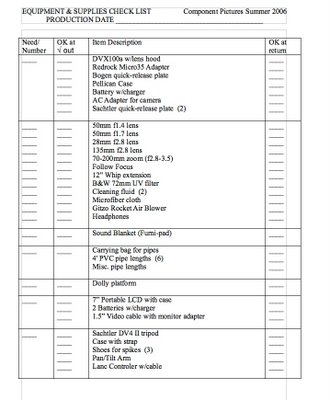Creating an equipment checklist
How many of the moviemakers out there have been in this situation? You pack everything into the car, arrive on location, pull out the camera and tripod- then you realize that you left the tripod adapter plate at home. I've had it happen to me twice, which is the main reason that I have taken to creating equipment checklists.
Equipment checklists can seem like an unnecessary step if you're just doing a short film, but I speak from experience when I say that they are as essential as the tape you are recording on. Basically, an equipment checklist is just like it sounds. It's a sheet (created in Excel) that lists what equipment is needed for the days' shooting. They are really quite easy to create, and they'll save you a lot of time in the long run.
First, open your spreadsheet program. (I use NeoOffice, cuz it's free). For my equipment checklists, I use a template given to me by my producer friend, Barbara. I like to create a header at the top stating the name of the project, the production company and the date. After that, create several columns down the entire length of the page. Add a few rows going across, and viola', you have a template.
 It should look something like above. (Click to enlarge)
It should look something like above. (Click to enlarge)From left to right, the columns are: Need/Number (# = serial number), OK at check out (this more important is if the gear is from a rental house), Item Description, and Ok at return (if the item is not ok at return, there is a space at the end of the document for comments.) At the very last page, create a large blank space (half the page or so) labeled "Comments". At the very bottom of the page, be sure to have an "Equipment Verified by" signature space and the date. This ensures that you receive the full blame for any problems later on.
I have divided this into different segments by creating new rows. The entire contents of my various cases is listed in it's own row. This helps me stay organized, by checking things bit by bit. As I go, I'm sure to check the appropriate items off the list. If there is something I can't find, I make a note of it and come back to it later. Often I will find the missing item in another case. If I don't find it, I usually go back into the house to find it.
If you are doing a movie that is fairly prop-heavy, it may be useful to use the template you created to make a property list/ wardrobe list. There's nothing worse than showing up to a shoot without a key prop. That's it for tonight kids. Check back tomorrow for more tomfoolery!

0 Comments:
Post a Comment
<< Home